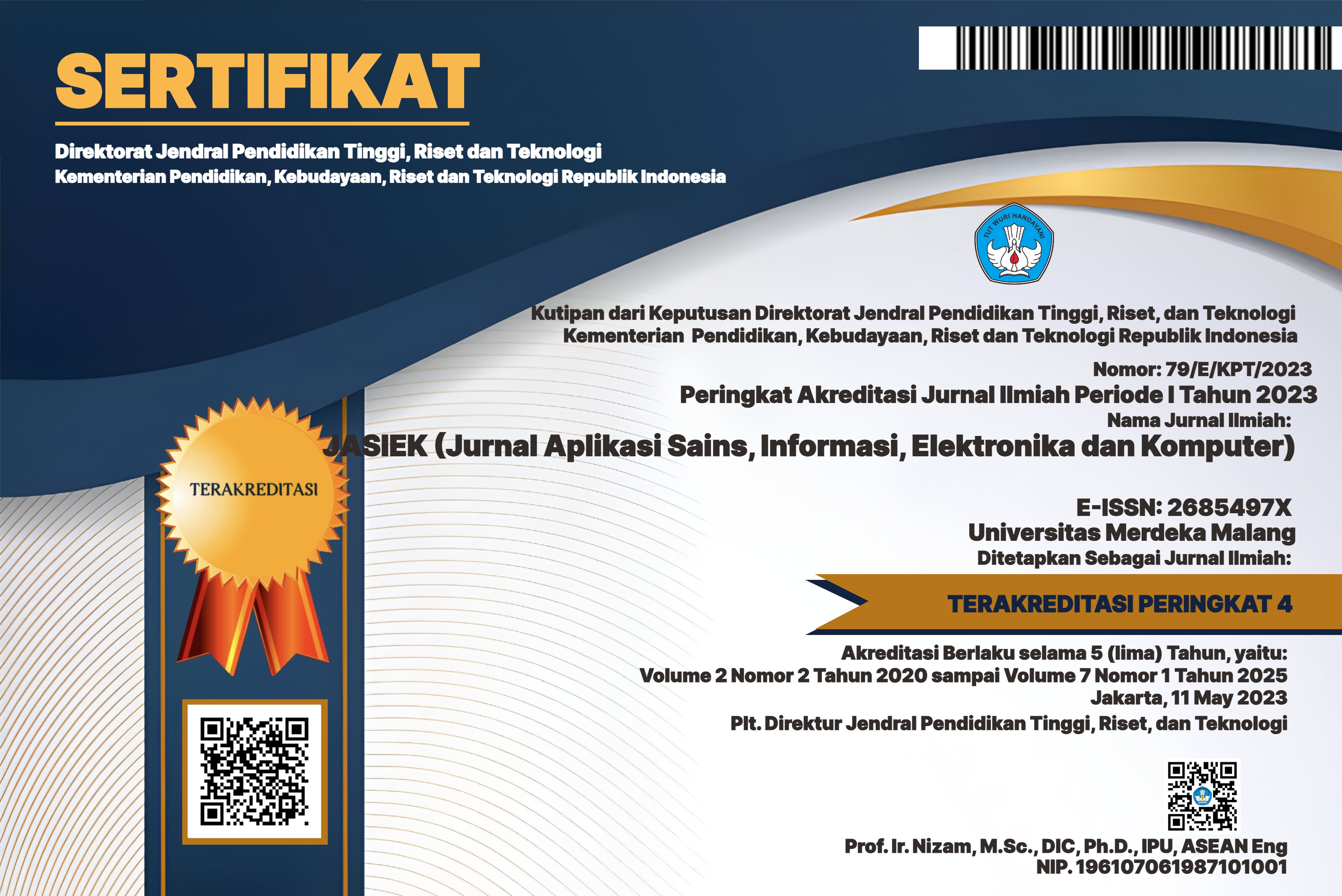FREQUENCY HOPPING VIDEO REAL TIME UNTUK PENGAMANAN DATA PENGINTAIAN OPERASI INTELIGENCE TNI
DOI:
https://doi.org/10.26905/jasiek.v1i1.3146Abstract
Saat ini multimedia telah berkembang sangat pesat dan digunakan secara luas di berbagai bidang khususnya dalam data tentang transmisi video. Penggunaan  teknologi ini dapat dimanfaatkan misalnya untuk mengirimkan video aktivitas yang sedang berlangsung sehingga orang lain dapat melihat kegiatan tersebut tanpa harus datang ke tempat untuk melihat video yang dikirimkan secara live atau real-time. Namun, keamanan data pada jaringan dalam hal kerahasiaan merupakan faktor keamanan yang perlu diperhatikan. Hal ini dikarenakan data yang ada pada jaringan menyebar ke area publik ataupun kepihak yang tidak bertanggung jawab sehingga memungkinkan untuk terjadinya pencurian data. Khususnya pada tugas militer. seperti Network Centric yang didalamnya ada suatu pola strategi yaitu Battle Management System. Jika pihak ketiga berhasil mendapat data berupa video streaming, maka orang tersebut dapat memantau kegiatan yang terjadi termasuk informasi penting di dalamnya. Dan juga mengetahui strategi yang sedang dijalankan. Oleh karena itu, diperlukan suatu metode pengamanan data video yang dikirim secara real time dengan menggunakan metode Frequency Hopping . Dimana metode ini bekerja dengan cara menyebar frekuensi yang bekerja dengan pola variabel yang acak sehingga membuat musuh atau hacker kesulitan untuk mendapatkan data video yang diinginkan.
Â
Downloads
References
S. Andi Setiono, “Prototipe Aplikasi KWh Meter Digital Menggunakan Mikrokontroler ATMEGA8535 untuk Ruang Lingkup Kamar,†J. Ilmu Pengetah. dan Teknol. TELAAH, 2009.
I. Mujahidin, R. Yuwono, and A. Mustofa, “Rancang Bangun Rectifier Antenna Mikrostrip Ufo Pada Frekuensi Ultra Wideband (UWB) Sebagai Pemanen Energi Elektromagnetik,†J. Mhs. TEUB, vol. 3, no. 2, 2015.
I. Daubechies, M. Barlaud, and P. Mathieu, “Image Coding Using Wavelet Transform,†IEEE Trans. Image Process., 1992.
R. Yuwono, I. Mujahidin, A. Mustofa, and Aisah, “Rectifier using UFO microstrip antenna as electromagnetic energy harvester,†Adv. Sci. Lett., 2015.
R. Y. Rahmanda, E. S. Pramukantoro, and W. Yahya, “Perancangan dan Implementasi Kelas Virtual FILKOM Universitas Brawijaya dengan Memanfaatkan Teknologi WebRTC (Web Real-Time Communication),†J. Pengemb. Teknol. Inf. dan Ilmu Komput., 2018.
I. Mujahidin, “Directional 1900 MHz Square Patch Ring Slot Microstrip Antenna For WCDMA,†JEEMECS (Journal Electr. Eng. Mechatron. Comput. Sci., 2019.
W. Arianti, A. Affandi, and D. S. Rahardjo, “Rancang Bangun Layanan Internet Protocol Television (IPTV) Terintegrasi Pada Jaringan IPTV Publik,†Jur. Tek. Elektro, Fak. Teknol. Ind. Inst. Teknol. Sepuluh Novemb., 2012.
Mujahidin, I., Pramono, S. H., & Muslim, A. (2018, October). 5.5 Ghz Directional Antenna with 90 Degree Phase Difference Output. In 2018 Electrical Power, Electronics, Communications, Controls and Informatics Seminar (EECCIS) (pp. 224-228). IEEE.
A. N. Putri, “Penerapan Fuzzy Controller Untuk Pergerakan Player Pada Game Engine 3d Berbasis Agen Cerdas,†J. Transform., 2017.
B. Arthayaa, A. Sadiyokob, and C. Wiejaya, “Pengembangan Algoritma Pengenalan Bentuk dan Arah Objek pada Sistem Omnidirectional Vision Sensor,†J. Tek. Elektro, 2013.
R. Wiryadinata, “Perancangan Roket Terkendali Penembak Pesawat Dilengkapi Chip Yang Terintegrasi Algoritma Cerdas,†in SNATI (Seminar Nasional Aplikasi Teknologi Informasi) 2007, 2007.
M. Luthfil, R. A. Anugraha, D. S. E. Atmaja, Ssss, and Sss, “Automation System Design of Ceramic Tile Rectangularity Identification with Harris Corner Detection Method in Balai Besar Keramik (BBK),†Univ. Telkom, S1 Tek. Ind., 2016.
Downloads
Published
Issue
Section
License
Authors who publish with this journal agree to the following terms:
The journal allow the authors to hold the copyright without restrictions and allow the authors to retain publishing rights without restrictions.
Authors retain copyright and grant the journal right of first publication with the work simultaneously licensed under a Creative Commons Attribution-ShareAlike 4.0 International License that allows others to share the work with an acknowledgement of the work's authorship and initial publication in this journal.
Authors are able to enter into separate, additional contractual arrangements for the non-exclusive distribution of the journal's published version of the work (e.g., post it to an institutional repository or publish it in a book), with an acknowledgement of its initial publication in this journal.
Authors are permitted and encouraged to post their work online (e.g., in institutional repositories or on their website) prior to and during the submission process, as it can lead to productive exchanges, as well as earlier and greater citation of published work (See The Effect of Open Access).

This work is licensed under a Creative Commons Attribution-ShareAlike 4.0 International License.










